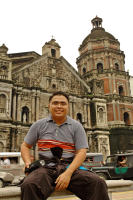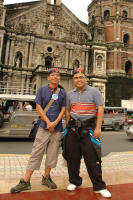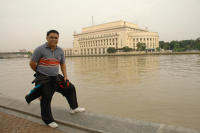Four hundred years of history and up to four hours of decadence!
The flavors of Old China are now in Manila. Come eat, talk, walk and then lose those calories as we explore the breadth, the width and most intimate alleys of Manila’s Chinese quarter!
We start, quite paradoxically, in a 16th-century Baroque cathedral while making our way down to a miraculous Chinese shrine! Take a peek at a traditional chocolate factory! Go Mama Mia over a mami house! Sing hurrahs to an authentic Hokkien lumpia! Savor the taste of an old panciteria!
We'll horse around the streets talking Filipino history, gorging Chinese treats and even checking out the district's Period architecture! Forget South Beach, it’s Tsinoy chop suey and more as we nibble our way down through Tsinoy town!

 We all met up with my tokayo at the Binondo Church where we began the brief trip around Chinatown. Manila's Chinatown actually encompasses three Manila districts namely Binondo, Santa Cruz and San Nicolas. These were pueblos during the Spanish colonial period before they were combined with Intramuros and other towns to form what is now the City of Manila.
We all met up with my tokayo at the Binondo Church where we began the brief trip around Chinatown. Manila's Chinatown actually encompasses three Manila districts namely Binondo, Santa Cruz and San Nicolas. These were pueblos during the Spanish colonial period before they were combined with Intramuros and other towns to form what is now the City of Manila.
The Binondo Church was built in 1596. It had undergone many changes since then, having sustained considerable damage from earthquakes and other natural disasters. Most of the church was destroyed during the Second World War. Today the octagonal bell tower and facade are all that remain of the 16th century construction. The reconstruction of the present church was funded by the Catholic Chinese community, many of whom reside or operate businesses in the area. The church is now a national shrine and a basilica minore for San Lorenzo Ruiz, the first Filipino saint who was born in Binondo.
Our next stop was one of the few remaining chocolate factories in Chinatown along the main street of the district, Ongpin Street. We got to take a peek inside but didn't see much since they were taking a siesta. The only activity going on inside was the crushing of cocoa beans in preparation for processing them into the traditional chocolate tablets used for hot chocolate.
Mezzanine Cafe was our first food stop where we had the rice dish kiampong and fish ball soup, both from southern China where most migrants to the Philippines come from. The cafe is actually the only themed cafe if Chinatown, showcasing the volunteer firefighter tradition of Chinese Filipinos.
After the war, Chinatown was victim to devastating fires. The government was slow to respond to these fires forcing the Chinese Filipinos to form groups of volunteer fire brigades. Today, these brigades are not only located in Chinatown but also in other parts of Metro Manila. Patronizing Mezzanine Cafe means donating to these volunteer fire brigades.
After that tasty snack, we went for a brief stop in a Chinese drug store before moving on to our next food stop along Nueva Street, a dumpling and pancake shop, with recipes originating from northern China. The taste of the dumplings and pancakes actually reminded me of the Japanese gyoza.
From Ongpin Street, we took made a brief detour to Salazar Street to savor some tea eggs - eggs boiled in tea, and cold pancit from Taiwan. The pancit was great! Egg noodles with veggies and ham if I'm not mistaken.
It was back to Ongpin Street and off to our next food stop, a fried siopao shop. Nope, these sumptuous dumplings are not deep-fried. They are steamed and cooked on a flat metal pan, rather than the one with holes. It's called fried since the bottoms of the siopao are browned to a slight crisp.
We made a brief visit to the Philippine-Chinese Buddhist Temple along Kipuja Street, which Ivan M. explains is actually a Taoist temple. There he gave us a background on Chinese religious practices.
According to a write-up of the temple, "with interiors ornately outlined in red and gold, the temple is one of the most frequented in the community. A shrine to Kuan Yin, goddess of mercy ans Kuan Te Ya, god of businessmen, it is visited daily by countless worshippers to light joss sticks, offer food, or simply to seek for guidance from these deities."
 From there, we walked to the next pueblo, Santa Cruz. As mentioned earlier, Manila during the Spanish colonial period was just Intramuros. Around it were several other towns, Binondo and Santa Cruz included.
From there, we walked to the next pueblo, Santa Cruz. As mentioned earlier, Manila during the Spanish colonial period was just Intramuros. Around it were several other towns, Binondo and Santa Cruz included.
Welcoming us at the end of Ongpin Street was Plaza Santa Cruz, with the grand Carriedo Fountain, built to honor the donor of Manila's first water system, Francisco Carriedo. At the other end of the plaza is the Santa Cruz Church.
On the right side of the church was Escolta Street, which at one time was the plush shopping area of Manila. Its art deco and beaux-arts buildings are a sight for sore eyes. The Heritage Conservation Society used to do an architectural walking tour of Escolta before called BEAUX PEEP!
The old ad went as follows: "The Heritage Conservation Society will be holding a tour of Manila's American-period financial district, the ESCOLTA. Relive the days of 1930's peace-time Manila with us as we guide you through some of Asia's oldest examples of Art Deco and Beaux-Arts Architecture. Some of the places we will visit are the First United Building, Burke Building, Regina Building, the Escolta Museum and the stunning beaux arts El Hogar Filipino by the Pasig River among others." The said buildings are indeed stunning.
 Near the end of Escolta, and a short walk to the banks of the Pasig River are one of the best views of the Post Office Building. From there, it was back to Binondo and our last food stop, a hidden lumpia joint in the art deco Uy Su Bin Building where our tour ended.
Near the end of Escolta, and a short walk to the banks of the Pasig River are one of the best views of the Post Office Building. From there, it was back to Binondo and our last food stop, a hidden lumpia joint in the art deco Uy Su Bin Building where our tour ended.
That's it for now. Darn that controllership final exam on Monday. I'm going to miss this month's tour of the Chinese cemetery which Ivan M. aptly calls Mounds, Magnates and Mausoleums. More of my Chinatown photos here.
Old Manila Walks: http://oldmanilawalks.blogspot.com
Related articles:
Pound the Binondo pavement with the Chinatown kid
Business in Binondo

Hi Ivan! Discovered your blogs and really admire you for doing a great service to all of us who love Philippine culture and want to preserve it.
ReplyDeleteMay I suggest that you update "Nibbling through Tsinoy town"? We just had a wonderful Pasig River tour from Guadalupe all the way down to exactly where you are standing in your last picture of the article! The new ferry is just great! Air-conditioned and its stations are like small airport terminals! Why not have a special "Ferry Tour on the Pasig"?
Ivan, sorry I forgot to leave my name on my post to "Nibbling our way through Tsinoy town". My apology. I am an expat who's fell in love with the Philippines in more ways than one! My wife and friends are all real Filipinos! We admire what you are doing very much! I've been here, teaching technology for 45 years! And remember so well the "Old Manila" of 1960 to 1970's. Those were the days!
ReplyDeletedo you remeber the kay susan tayo march 22 episode..you were in a quest to find the best noodle and dumplings in town.i forgot the name of the place you suggested can you still remember?can you please tell me?you can email me at im_charmed8@yahoo.com...tnx a heap i'll wait for your response
ReplyDeleteGreat information! I’ve been looking for something like this for a while now. Thanks!
ReplyDelete